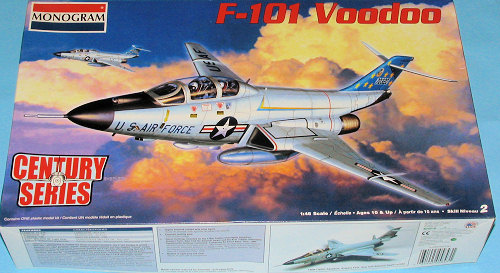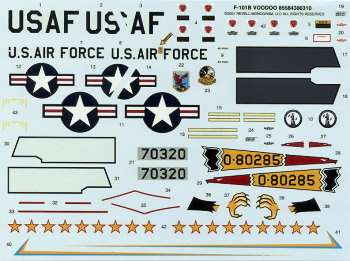
| KIT: | Monogram 1/48 F-101B Voodoo |
| KIT #: | 5843 |
| PRICE: | $15.95 MSRP in 2001 |
| DECALS: | Two options |
| REVIEWER: | Scott Van Aken |
| NOTES: | Reissue |

| HISTORY |
The McDonnell Voodoo was a supersonic fighter designed to escort bombers and serve as a fighter bomber, an all-weather interceptor and a photoreconnaissance aircraft. It served during the Cuban Missile Crisis and during the Vietnam War.
It began as the XF-88 all-weather interceptor (fighter), which first flew at Muroc Dry Lake Air Base, Calif., in 1948. The two prototypes evolved into the F-101 Voodoo.
McDonnell delivered 807 F-101 Voodoos, designed as long-range, twinjet fighters to escort bombers, attack distant targets and provide close support for ground troops. Attack fighter, interceptor and reconnaissance versions served with the U.S. Air Force Strategic Air, Air Defense and Tactical Air Commands and in Canada.
Voodoo versions included the F-101A fighter-bomber; the F-101B two-seat, long-range interceptor; the RF-101A photoreconnaissance version; the RF-101C single-seat reconnaissance version; the TF-101B trainer version; the F-101C -- an upgraded F-101A; and the CF-101F -- built under license in Canada.
In Operation Firewall on Dec. 12, 1957, an F-101A fighter-bomber set a world speed record of 1,207 mph. In Operation Sun Run in 1957, an RF-101 raced from Los Angeles, Calif., to New York and back to Los Angeles in a record time of 6 hours 46 minutes.
The last Voodoo retired in 1986.
The above from the Boeing website. What is particularly sad is that there were no license built Voodoos, all came from the McDonnell plant in St. Louis. So much for professional research.
The F-101B was one of the mainstay interceptors for the USAF and later for the ANG, where they served until the early 1980s when most Guard units replaced their Voodoos with Phantoms. The Voodoo was also armed for a time with the nuclear tipped 'Genie' missile. One often wonders what the survival prospects were for the crew that launched this device. Such was the thinking of the Cold War. The CAF was the last to use the Voodoo, retiring their special black electronic warfare aircraft that was serving with 414Sq in 1986.
| THE KIT |
 By now, most of you will have either build or at least owned one of these kits. First issued in the late 70's or early 1980s at the end of the Voodoo's career, the kit has all the mods that were incorporated in the last operational planes. Means that if doing an early plane, one has to at least remove the slime lights. It is quite a large kit as the plane itself was not small, needing lots of space to carry fuel for those two thirsty turbojets.
By now, most of you will have either build or at least owned one of these kits. First issued in the late 70's or early 1980s at the end of the Voodoo's career, the kit has all the mods that were incorporated in the last operational planes. Means that if doing an early plane, one has to at least remove the slime lights. It is quite a large kit as the plane itself was not small, needing lots of space to carry fuel for those two thirsty turbojets.
This is the 2001 and most recent boxing of the kit. Thankfully, the molds seem to be in excellent condition as there wasn't a hint of flash, nor could I find any sink areas. I did find some ejector pin marks on inner gear doors, missile bodies and landing gear, the usual places for kits from this era. Of course, it is all raised detail and extremely well done. One thing about Monogram kits is that they provide you all the detail you could want. The various wells and cockpit are superbly appointed with well done seats that have the belts molded in place. You will also find a crew of two to occupy those seats if you should so wish.
A few options are for a raised or lowered canopy, open or closed speed brakes and a rotating weapons bay, complete with Genie and Falcon missiles. A pair of mandatory drop tanks are also included. One thing about Monogram kits that some do not like is that the gear doors are often molded in with the wheel well part, making clean-up around the doors difficult. Those who are concerned can cut them off and reattach later, but I will agree that having them in the way is asking for them to be damaged.
The instructions are very well done with nicely drawn construction sequences that include any color information A color chart with generic and FS 595 colors is provided. Markings are for two aircraft. One an early F-101B from the 87th FIS as shown on the box art, and the other from the 136 FIS, NY ANG. Both are in overall ADC Grey and the decals are quite well done, so unless you want another scheme, these will work just fine. No indication of nose weight is given and it may not need any with its long wheelbase, but I'd stick in a little just to be sure.
| CONCLUSIONS |
I last built this kit in 1986, using the Texas ANG markings that were in the kit. It was a big model then and it is a big model now. It takes a bit of skill in that it must be carefully built to eliminate any fit problems, but your additional diligence will pay off with a big honking model that will look great on your shelves. There are also oodles of aftermarket sheets available for this one.
| REFERENCES |
Won this one at a raffle. You may now thank me.
If you would like your product reviewed fairly and quickly by asite that has over 325,000 visitors a month, please contactme or see other details in the